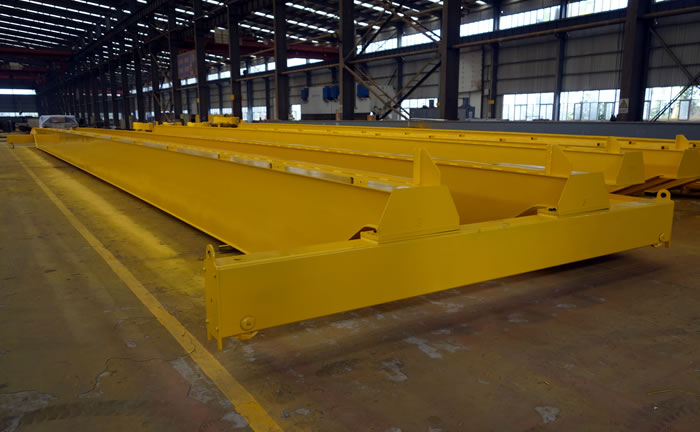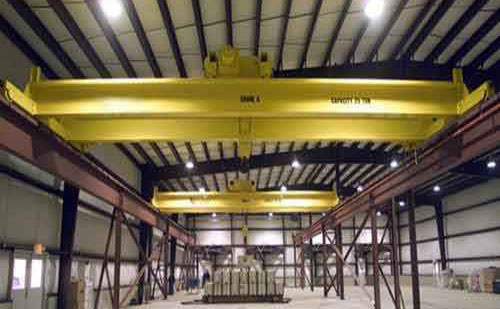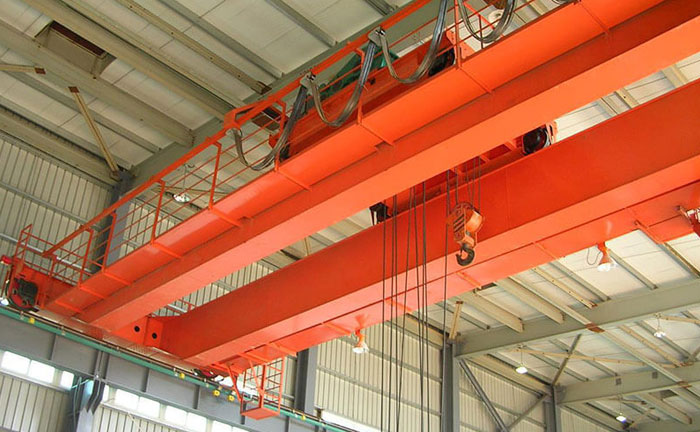100 Ton Overhead Crane
A 100 ton overhead crane is a formidable industrial lifting solution renowned for its immense strength and versatility across a multitude of sectors. With a capacity to hoist and transport heavy loads weighing up to 100 tons, these overhead cranes play a pivotal role in streamlining material handling operations in industries ranging from manufacturing and construction to shipbuilding and mining. Characterized by their robust construction, precise control systems, and adherence to stringent safety standards, 100 ton overhead cranes offer unparalleled efficiency and reliability in lifting and moving massive objects with precision and ease.



1. Steel Manufacturing:
Different Types of 100 Ton Overhead Crane Price:

100 Ton Double Girder Overhead Crane Price:
- Lifting capacity (T): 5~550t
- Lifting span: 10.5~35.5m
- Power supply(V): 220-480/3/50
- Price(USD): $50,000 to $200,000
- Double girder crane have two girders running parallel, providing increased stability and lifting capacity.
- Ideal for heavy-duty applications and lifting heavier loads.
- Commonly used in steel mills, foundries, and other industrial settings.

100 Ton Top-Running Overhead Crane Price:
- Lifting capacity: 1~350t
- Lifting span(m): 10.5~31.5m
- Power supply(V): 220-480/3/50
- Price(USD): $30,000 to $150,000
- Top-running overhead crane travel on elevated runways, typically attached to the ceiling structure.
- Suitable for maximizing vertical lifting space and covering a large area.
- Used in various industrial applications.

100 Ton Overhead Crane with Hook Price:
- Lifting capacity (T): 5~550t
- Lifting span: 10.5~35.5m
- Power supply(V): 220-480/3/50
- Price(USD): $50,000 to $150,000
- A standard overhead crane with a hook attachment for lifting various types of loads.
- Versatile and used in a wide range of industries and applications.
How to Maintain and Extend the Lifespan of Your 100 Ton Overhead Crane:
Maintaining and extending the lifespan of your 100 ton overhead crane is essential for ensuring safety, efficiency, and reliability in your operations. Here are some key maintenance practices to follow:- Lubrication: Ensure proper lubrication of all moving parts, such as gears, bearings, wheels, and ropes/chains. Regularly check lubrication points and replenish lubricants as needed to prevent friction, wear, and premature failure of components.
- Electrical System Maintenance: Inspect electrical components, such as wiring, connectors, switches, and control panels, for signs of damage or wear. Test electrical systems regularly for proper functioning, including motor operation, limit switches, brakes, and emergency stop controls. Keep electrical components clean and free from dust, debris, and moisture to prevent electrical faults and breakdowns.
- Structural Integrity: Monitor the structural integrity of the crane, including the main bridge, girders, and runway beams. Look for signs of cracks, deformation, or corrosion. Repair or replace damaged or worn structural components promptly to prevent structural failure or collapse.
- Operational Safety: Ensure that crane operators are properly trained and certified to operate the equipment safely and efficiently. Conduct regular safety inspections of the work area to identify and mitigate potential hazards, such as obstructions, uneven surfaces, or overhead obstacles.
- Emergency Preparedness: Develop and implement emergency response procedures for crane-related incidents, including rescue and evacuation protocols. Ensure that emergency stop controls and safety features are functional and easily accessible in case of an emergency.
Features And Advantages Of 100 Ton Overhead Crane:
- High Lifting Capacity: The primary feature of a 100 ton overhead crane is its ability to lift and move heavy loads weighing up to 100 tons with ease. This makes it suitable for handling large and bulky materials in industries such as steel manufacturing, shipbuilding, automotive, and construction.
- Double Girder Design: Many 100 ton overhead cranes feature a double girder design, which provides enhanced stability, strength, and lifting capacity compared to single girder cranes. The double girder configuration allows for greater span distances and increased lifting heights, making it ideal for heavy-duty applications.
- Precise Control: Advanced control systems, such as variable frequency drives (VFDs) and radio remote controls, enable precise and smooth operation of the 100 ton overhead crane, allowing operators to position loads accurately and safely.
- Customizable Configurations: 100 ton overhead cranes can be customized to meet specific lifting requirements and facility layouts. Options for customization include span length, lifting height, hoist speed, trolley travel speed, and control features to optimize performance and productivity.
- Safety Features: 100 ton overhead crane are equipped with a range of safety features to ensure safe operation in the workplace. These may include overload protection devices, emergency stop buttons, limit switches, and collision avoidance systems to prevent accidents and protect personnel and equipment.
- Versatility: 100 ton overhead crane are versatile lifting solutions that can be used for various tasks, including loading and unloading, assembly, maintenance, and material handling across different industries and applications.
- Long Service Life: Well-maintained overhead cranes have a long service life, providing reliable performance and durability for years of operation.
- Adaptability: 100 ton overhead crane can be installed in various indoor and outdoor environments, including warehouses, manufacturing facilities, ports, and construction sites. They can be designed to operate in harsh conditions, such as extreme temperatures, corrosive environments, or hazardous areas.
Applications of 100 Ton Overhead Cranes Across Industries:
100 ton overhead cranes find extensive use across a wide range of industries due to their robust lifting capabilities and versatility. Here are some real-world applications of 100 ton overhead cranes in various industries:1. Steel Manufacturing:
- Handling and moving raw materials such as steel coils, billets, and ingots within steel mills.
- Transporting and positioning heavy machinery and equipment during production processes.
- Loading and unloading finished steel products onto trucks or railcars for distribution.
- Lifting and maneuvering large ship components, such as hull sections, decks, and machinery, during the construction of ships and offshore structures.
- Moving heavy ship modules within shipyards for assembly and outfitting.
- Loading and unloading ship parts and equipment onto transport vessels for delivery to shipyards or assembly sites.
- Handling and positioning heavy automotive components, such as chassis, engines, transmissions, and body panels, on assembly lines.
- Transporting and storing large automotive parts and assemblies within manufacturing facilities.
- Loading and unloading vehicles onto trailers or railcars for shipment to dealerships or distribution centers.
- Lifting and placing precast concrete elements, steel beams, and structural components at construction sites.
- Moving heavy construction materials, such as stone blocks, pipes, and prefabricated modules, on building sites.
- Assisting with the erection of large structures, such as bridges, stadiums, and industrial facilities, by lifting and positioning heavy components.
- Handling and transporting bulk materials, such as ore, coal, and aggregates, in mining and quarry operations.
- Loading and unloading heavy mining equipment, trucks, and haulage vehicles at extraction sites.
- Assisting with maintenance and repair tasks by lifting and moving large machinery and components in mining facilities.
- Loading and unloading cargo containers, bulk materials, and heavy machinery from ships and barges at port facilities.
- Moving shipping containers and cargo between storage yards, quayside, and container terminals.
- Assisting with ship-to-shore and intermodal container handling operations to facilitate efficient cargo transfer and logistics.
- Installing and maintaining heavy equipment and components in power plants, including turbines, generators, boilers, and transformers.
- Handling and positioning large infrastructure elements, such as cooling towers, chimneys, and transmission towers, at power generation facilities.
- Transporting and storing fuel, such as coal, biomass, or nuclear fuel rods, within power plants for energy production.
There is no new information in this column yet